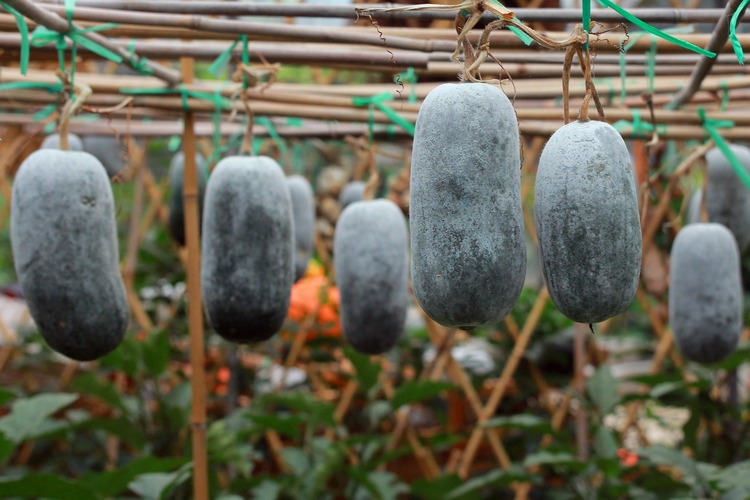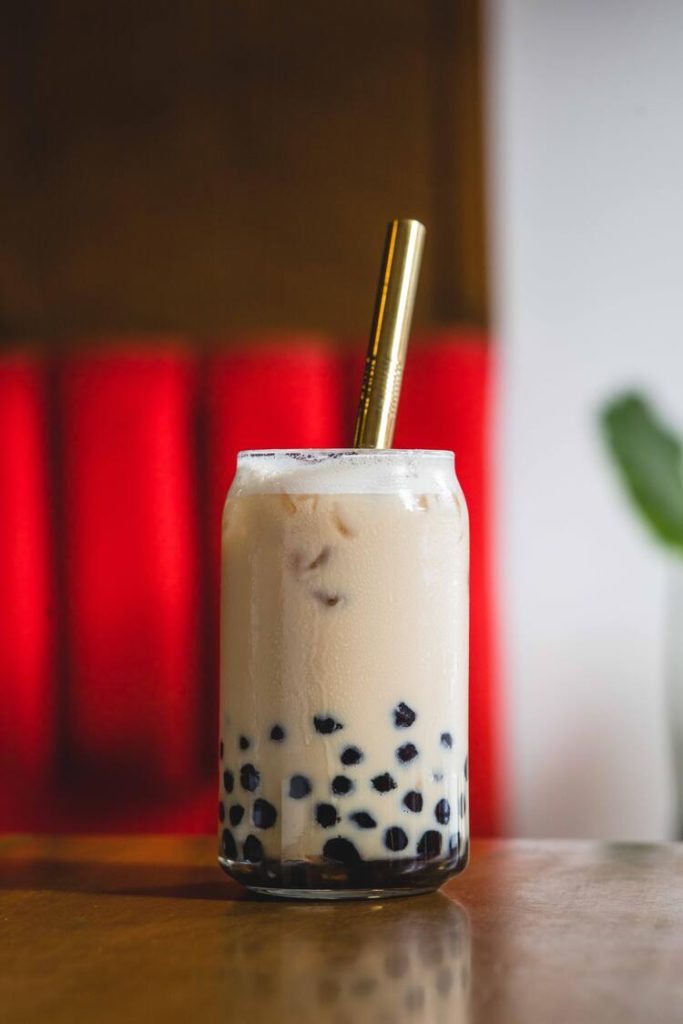Are you a fan of milk tea? If so, you might want to try Wintermelon Milk Tea. This drink has recently gained popularity and has become a favorite among milk tea enthusiasts.
Wintermelon Milk Tea is made with tea (mainly black), milk, and wintermelon syrup, which gives it a unique flavor that sets it apart from other milk tea drinks. The syrup is made from wintermelon, a type of fruit that is commonly used in Chinese cuisine. It has a mild, sweet taste that complements the tea’s bitterness and the milk’s creaminess.
If what I have mentioned above grabbed your attention, keep reading because we are discussing different aspects of this beverage below.
Please note: This article contains affiliate links, meaning I may earn a commission if you make a purchase by clicking a link. Of course, this comes at no extra cost to you and helps me keep offering readers solid information.

What is Wintermelon Milk Tea?
Wintermelon is a type of melon commonly used in Asian cuisine, particularly in Chinese and Taiwanese dishes (mainly consumed as a vegetable). It has a greenish-brown skin and a white flesh that is crisp and mildly sweet. Wintermelon is also known as white gourd, wax gourd, or ash gourd.
To prepare wintermelon milk tea, black or green tea is typically brewed and combined with milk and wintermelon syrup. The tea is usually served over ice, making it a refreshing and cooling beverage, especially during hot weather.
Wintermelon milk tea can be customized according to personal preferences. Some people prefer it with a stronger tea flavor, while others like it sweeter or less sweet. Toppings such as tapioca pearls (boba), jelly, or pudding can also be added to enhance the texture and overall experience of the drink.
What Does Wintermelon Milk Tea Taste Like?
Wintermelon milk tea has a flavor profile that combines the following elements:
- Sweetness: Wintermelon milk tea is known for its sweetness. The sweetness primarily comes from the syrup or sweetener used in the drink, which can be adjusted to suit individual preferences. The sweetness is usually balanced to complement the other flavors.
- Creaminess: The “milk” in wintermelon milk tea contributes to its creamy and smooth texture. Standard milk options include regular, condensed, or non-dairy milk like almond or soy milk. The choice of milk can influence the overall creaminess.
- Wintermelon Flavor: The dominant flavor in wintermelon milk tea is derived from wintermelon syrup or flavoring. Wintermelon has a mild, subtly fruity taste, often likened to a combination of honeydew melon and cucumber. It is not overly sweet on its own, which allows it to pair well with the sweetness of the syrup and milk.
- Tea Base: Many versions of wintermelon milk tea also incorporate a tea base. Black tea or green tea is commonly used, but the type of tea can vary depending on the recipe or personal preference. The tea adds depth and complexity to the flavor.
- Ice: Wintermelon milk tea is often served cold, so ice is typically included. The ice helps to chill the drink and can dilute the sweetness and creaminess slightly as it melts.
- Toppings (Optional): Some variations of wintermelon milk tea include toppings like tapioca pearls (boba), jelly cubes, or fruit bits for added texture and flavor.

How to Make Wintermelon Milk Tea
Alright, here’s how you prepare this flavorful milk tea at home.
Homemade Wintermelon Syrup
To make wintermelon syrup, you’ll need peeled and cubed wintermelon, sugar, and water. Here’s how to do it:
- Combine 2 cups of peeled and cubed wintermelon, 1 cup of sugar, and 1 cup of water in a medium pot.
- Bring the mixture to a boil over medium-high heat, stirring occasionally.
- Reduce the heat to low and let the mixture simmer for 30 minutes, stirring occasionally.
- Remove the pot from the heat and let the mixture cool.
- Strain the mixture through a fine-mesh strainer, pressing on the solids to extract as much liquid as possible.
- Store the syrup in an airtight container in the fridge for up to 2 weeks.
Cooking Tapioca Pearls
Tapioca pearls are an essential ingredient in any boba tea. Here’s how to cook them:
- Bring a pot of water to a boil.
- Add the tapioca pearls and stir to prevent them from sticking together.
- Cook the pearls for 15-20 minutes or until they’re soft and chewy.
- Drain the pearls and rinse them under cold water.
- Add a tablespoon of wintermelon syrup to the pearls and stir to coat them.
Making Wintermelon Milk Tea
Now that you have your wintermelon syrup and cooked tapioca pearls, you’re ready to prepare the milk tea. Here’s how:
- Brew a cup of tea leaves according to the package instructions. You can use green, black, or oolong tea.
- Let the tea cool down to room temperature.
- Add a tablespoon of wintermelon syrup to the tea and stir to combine.
- Add your choice of dairy or non-dairy milk (such as oat, almond, soy, or whole milk) to the tea and stir to combine.
- (Optional) Add honey or sugar to taste for an additional touch of sweetness
- Add ice to a tall glass.
- Pour the wintermelon milk tea over the ice.
- Add your cooked tapioca pearls as a topping. You can add jelly or pudding instead of tapioca balls.
- Enjoy!
Feel free to use syrup bought from the supermarket or an online retailer.

Variations of Wintermelon Milk Tea
If you’re a fan of wintermelon milk tea, you’ll be happy to know there are various ways to enjoy this delicious drink. Here are some popular variations that you can try:
Jasmine Milk Tea
If you love floral flavors, you’ll enjoy jasmine milk tea. This variation includes jasmine tea, which gives the drink a fragrant and slightly sweet taste. To make jasmine milk tea, brew jasmine tea and mix it with wintermelon syrup, creamer, and ice. You can adjust the sweetness and creaminess to your liking.
With Brown Sugar
Try adding brown sugar syrup for a more decadent and indulgent milk tea variation. Brown sugar syrup has a caramel-like flavor that pairs well with wintermelon syrup. To make this variation, mix brown sugar syrup with wintermelon syrup, creamer, and ice. You can also add boba or taro balls for a chewy texture.
With Fruit
Try adding fruit purees if you want a refreshing and fruity twist to your milk tea. Mango, strawberry, and peach purees are popular choices that complement the wintermelon flavor. To make this variation, mix fruit puree with wintermelon syrup, creamer, and ice. For a fun and colorful drink, you can also top it with whipped cream and fruit chunks.
With Coconut Milk
Replace regular milk with coconut milk for a creamy and tropical twist. The combination of wintermelon and coconut adds a nutty flavor to the milk tea.
Wintermelon Matcha Latte
Replace regular tea with matcha powder to create a wintermelon-infused matcha latte. Whisk matcha powder with a small amount of hot water to create a paste, then add chilled milk and wintermelon syrup. Mix well until smooth, and enjoy matcha’s rich and earthy flavors combined with wintermelon.

Buying Recommendations
Here are some recommendations for preparing our featured milk tea at home.
TEA ZONE 64 fl. oz Winter Melon Syrup

Organic Positively Tea Company, Assam TGFOP Black Tea

Organic English Breakfast Loose Leaf Tea


WuFuYuan – Tapioca Pearl Black

Frequently Asked Questions
Is Wintermelon Milk Tea Caffeinated?
The level of caffeine in this milk tea depends on the type of tea used as the base. If black tea is used, the traditional choice, it contains caffeine. However, if you opt for green or caffeine-free herbal tea as the base, the milk tea will have less or no caffeine.
Can I Make Wintermelon Milk Tea Without Milk?
You can make a dairy-free version of wintermelon milk tea using non-dairy alternatives such as almond milk, soy milk, or coconut milk. Simply substitute regular milk with your preferred non-dairy milk option in the recipe.
Where Can I Find Wintermelon Syrup or Flavoring?
Wintermelon syrup or flavoring is typically found in Asian grocery stores or specialty tea shops. You can also purchase it online from various retailers. If you cannot find wintermelon syrup, you can try making your own by simmering and reducing wintermelon juice with sugar until it thickens to a syrup-like consistency.
Can I Adjust the Sweetness of Wintermelon Milk Tea?
Yes, the sweetness of the milk tea can be adjusted according to personal preference. You can add more or less wintermelon syrup or use additional sweeteners such as honey, sugar, or simple syrup to achieve your desired level of sweetness.
Wintermelon Fun Facts
And we cannot close the article without presenting some fun facts about wintermelon.
- Botanical Background: Wintermelon (Benincasa hispida) belongs to the gourd family (Cucurbitaceae) and is related to other familiar vegetables like pumpkins, zucchinis, and cucumbers.
- Size Matters: Wintermelons can grow to be quite large, with some reaching lengths of up to 3 feet (1 meter) or more. They can sometimes weigh anywhere from a few pounds to over 50 pounds (22.7 kg).
- Tough Exterior: The outer skin of a wintermelon is thick and waxy, where it gets its alternative name, “wax gourd.” This thick skin helps the fruit to have a long shelf life, making it a popular choice for storing and preserving.
- Pale Green Color: Wintermelons are typically pale green and have a smooth, matte surface. They may look somewhat similar to watermelons in shape, but their color and texture are quite different.
- Versatile in Cooking: Wintermelons are used in various culinary applications. They are commonly used in Asian cuisines, both in savory and sweet dishes. The flesh of the wintermelon is mild in flavor and takes on the taste of the other ingredients it’s cooked with, making it a versatile ingredient.
- Traditional Medicine: In traditional Chinese medicine, wintermelon is believed to have various health benefits. It is often used to soothe sore throats, reduce inflammation, and as a diuretic.
- Hollow Center: When you cut open a wintermelon, you’ll find a hollow center filled with seeds and a spongy, fibrous core. The edible seeds can be roasted or used to grow new wintermelon plants.
- Symbolism: In some cultures, wintermelons hold symbolic significance. They are sometimes used as offerings during religious ceremonies or festivals and symbolize prosperity and good luck.
- Growth and Storage: Wintermelons are typically grown in warm climates and are harvested in late summer or early autumn. Due to their thick skin, they have a long shelf life and can be stored for several months when kept in a cool, dry place.
I hope you have enjoyed the article and ended up with a new recipe under your belt. See you next time.
Have you tried this milk tea?
More About Milk Tea
What Does Milk Tea Taste Like?
What Does Thai Milk Tea Taste Like?
What Does Honeydew Milk Tea Taste Like?
What Does Taro Milk Tea Taste Like?
What Does Tiger Milk Tea Taste Like?
Everything About Tiger Milk Tea
What Does Jasmine Milk Tea Taste Like?